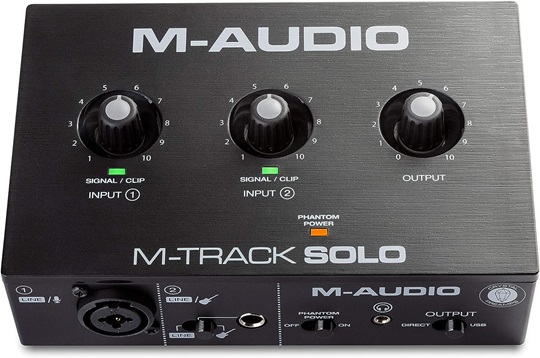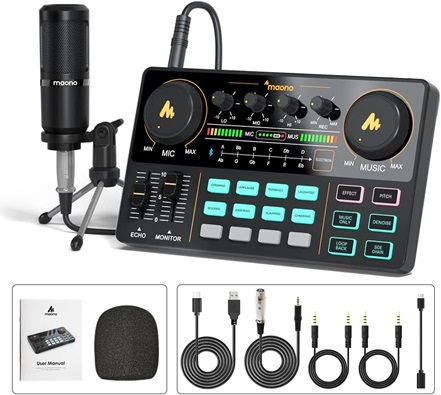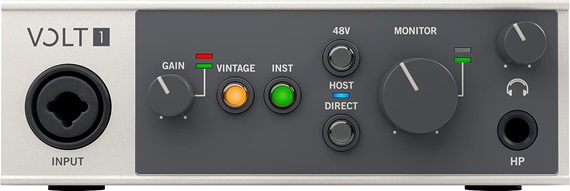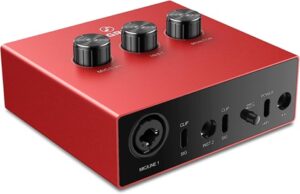For singers, musicians, or podcasters, an audio interface is key to upgrading a home studio to professional recording setup. But choosing the right one can be tough with so many options out there. We made your search easier by testing several interfaces and considered the inputs of audio engineers as well. And finally, we picked the best interface for home studio based on three main factors. Here’s what should keep in mind:
- Audio Quality: For professional-grade recordings, aim for interfaces supporting 24-bit/192 kHz. For basic needs like podcasting, 48 kHz/16-bit may be adequate.
- Connection Type: For computers and laptops, prefer a model with USB and USB-C ports. For smartphone use, check for interfaces offering 1/8-inch or USB-C ports.
- Number of Channels: Based on your usage, if you are recording a band or multi-layer tracks, look for interfaces with multiple channels. For solo work, a single-channel might suffice.
Outline
ToggleBest Interface For Home Studio Table
| Best Interface for Home Studio | Connectivity Technology | No. of Channels | Audio Resolution | Buy Now |
|---|---|---|---|---|
| M-Audio Interface For Home Studio | USB | 2 | 48 kHz | Check On Amazon |
| PreSonus Interface For Home Studio | USB | 2 | 24-bit or 96 kHz | Check On Amazon |
| MAONO Interface For Home Studio | 1/8inch/USB TYPE C | 9 | -- | Check On Amazon |
| Universal Audio Interface for Home Studio | USB | 1 | 24-bit/192 kHz | Check On Amazon |
| RSGRHAI Interface For Home Studio | USB | 2 | 48 kHz | Check On Amazon |
Best Interface For Home Studio Reviews
1. M-Audio Interface For Home Studio
Why it made the cut: Portable, Versatile, Crystal Clear Sound.
M-Audio caters perfectly to enthusiasts of home studios, facilitating seamless recording, streaming, and podcasting endeavors. Its compact design, coupled with top-notch 48 kHz audio quality, guarantees exceptional sound in your recordings. Its versatile inputs accommodate both microphones and instruments, while the Crystal Preamp ensures pristine sound reproduction, capturing every nuance with precision.
Monitoring your recordings is effortless with its headphone and RCA outputs. Being USB-powered, it offers portability for recording on the go. Additionally, it includes the MPC Beats Software, catering to all your recording requirements. Whether crafting music or podcasts, the M-Track Solo consistently delivers outstanding outcomes.
Specifications
- 48 kHz audio resolution
- Single combo XLR/Line input
- Transparent Crystal Preamp
- 1/8” headphone output
- Stereo RCA outputs
- USB-powered
- MPC Beats Software included
- Zero-latency monitoring
- Compatible with Mac and PC
- Compact and portable design
Pros
- Transparent Crystal Preamp for optimal sound.
- Versatile inputs for various recording sources.
- USB-powered for portability.
- Includes MPC Beats Software for production.
Cons
- Power issues.
2. PreSonus Interface For Home Studio
Why it made the cut: High-Resolution Recording, Professional Software Included.
PreSonus serves as an ideal companion for your recording endeavors, boasting two premium XMAX-L solid-state mic preamps that ensure your recordings exhibit unparalleled clarity and precision. With professional-grade converters enabling high-fidelity 24-bit/96 kHz recording and playback, your audio projects attain exceptional quality.
Easily monitor your levels with the LED display and enjoy minimal latency through direct monitoring. Bundled with Studio One Artist and Ableton Live Lite DAW Recording Software, as well as the Studio Magic Plug-In Suite, this package equips you with all essential tools for superior recordings. Whether you’re a novice or an expert in recording, the Studio 24c caters to your needs seamlessly.
Specifications
- Two XMAX-L solid-state mic preamps
- Studio-grade converters (up to 24-bit/96 kHz)
- Ladder-style LED monitoring
- Low-latency direct monitoring
- Studio One Artist and Ableton Live Lite included
- Studio Magic Plug-In Suite included
- Two high-headroom instrument/line inputs
- Balanced ¼-inch TRS main outputs
- +48V phantom power for condenser mics
- Built-in MIDI interface
Pros
- High-resolution recording capability.
- Professional software included.
- Pristine XMAX-L mic preamps.
- Compact and rugged design.
Cons
- Limited to 2 channels.
3. MAONO Interface For Home Studio
Why it made the cut: All-in-One Podcasting Solution.
MAONO Podcast kit has everything you need to create top-notch audio content, offering easy control over vocals and sound effects. With the S1 bundle, you can quickly begin podcasting, live streaming, or DJing. It includes a condenser microphone for clear recording on smartphones or PCs.
The MAONO soundboard features four user-recordable and eight built-in audio effects, allowing for endless creativity. With support for up to two people, four devices, and four platforms for simultaneous streaming, it’s ideal for collaborations and live performances. Real-time monitoring and noise reduction ensure your productions sound polished and professional every time.
Specifications
- All-in-one audio mixer station
- Condenser microphone included
- Four user-recordable audio effects
- Eight built-in special audio effects
- Real-time monitoring with noise reduction
- Compatible with IOS and Android systems
- Supports up to two people, four devices, and four platforms simultaneously
- Built-in Bluetooth wireless accompaniment music input
Pros
- Comprehensive podcasting solution.
- Intuitive and full control over sound effects.
- Supports multiple devices and platforms simultaneously.
- Real-time monitoring with noise reduction.
Cons
- Microphone quality issues.
4. Universal Audio Interface for Home Studio
Why it made the cut: Vintage Mic Preamp Mode.
This compact audio interface guarantees exceptional sound quality for your recordings. Featuring a Vintage Mic Preamp mode, it enables you to capture vocals and instruments with a cozy, full-bodied sound. It works seamlessly with Mac, PC, iPad, or iPhone, powered conveniently via USB for effortless recording anywhere.
When using this, you can benefit from smooth recording with direct monitoring and 48V phantom power for condenser microphones. Its intuitive design caters to both novices and professionals. Additionally, it comes with premium software such as Ableton and Melodyne, providing limitless creative possibilities right from the start.
Specifications
- Desktop 1-in/2-out USB 2.0 audio interface
- Built-in Vintage Mic Preamp mode
- USB bus-powered
- 24-bit/192 kHz audio conversion
- Studio-quality headphone amp
- MIDI connections
- 48V phantom power
- Direct monitoring for latency-free recording
Pros
- Vintage Mic Preamp mode adds warmth.
- USB bus-powered for portability.
- Simple controls for easy operation.
- Bundled with industry-leading software.
Cons
- Limited to 1 channel.
5. RSGRHAI Interface For Home Studio
Why it made the cut: Budget-Friendly Professional Recording.
RSGRHAI’s 2 inputs/2 outputs configuration allows for versatile recording of microphones and instruments, ensuring minimal delay with ultra-low latency streaming to your computer. Achieve high-quality recordings effortlessly with its professional-grade audio and the maximum sampling rate of 48 kHz at 16-bit.
Compatible with popular recording software like Avid Pro Tools, Ableton Live, and Steinberg Cubase, it seamlessly integrates into your setup whether you’re on Windows PC, Mac, Android, or iOS. Portable and compact, it’s ideal for on-the-go recording. Despite its budget-friendly price, the RSGRHAI USB Audio Interface offers exceptional value and performance for all levels of users.
Specifications
- 2 inputs/2 outputs configuration
- Ultra-low latency streaming
- Maximum sampling rate: 48 kHz, 16-bit
- Compatible with Avid Pro Tools, Ableton Live, Steinberg Cubase, and more
- Compatible with Windows XP to Windows 10, Android 6.0 to 12, and iOS systems
- Compact and portable design
Pros
- Budget-friendly price.
- Professional-grade audio quality.
- Compatible with popular recording software.
- Versatile compatibility with various operating systems.
Cons
- Requires additional adapters for certain devices.
Buying Guide Features For The Best Interface For Home Studio
When choosing an audio interface for your home studio, it’s important to think about a few important features. These features affect how well the interface works and how good your recordings sound. Knowing about these things will help you pick the right interface for your recording setup.
1. Connectivity Technology
Different interfaces use different technologies like USB, USB-C, Thunderbolt, and FireWire. USB ones are good for lots of stuff like computers, laptops, and tablets. They’re pretty versatile. USB-C ones are faster and pros like them more. When picking one, think about what gear you have now and what you might get later for your studio.
2. Number of Channels
The number of channels on an audio interface determines how many different sounds you can record at once. Having more channels gives you the freedom to record various things like vocals, instruments, and other sounds separately. If you only have one channel, you can still record, but it might restrict what you can do, especially if you want to record multiple things at the same time.
3. Audio Resolution
Audio resolution means how clear and detailed the sound is when it’s recorded. Better resolution means you can hear more details in the recording, making it sound more lifelike. We measure resolution in bits, with higher numbers like 24-bit being better because they capture more nuances in the sound. Sampling rate, measured in kHz, determines how much of the sound’s frequency range is captured. Higher sampling rates, like 44.1 kHz or 48 kHz, give you better quality sound.
4. Sound Quality
The quality of sound in an audio interface is super important for good recordings. Good preamps, converters, and other parts help keep the sound clear and accurate, so your recordings sound great. It’s smart to choose interfaces made by trusted brands that care about sound quality and reliability. Check out what other users say and listen to samples to see if the interface you’re considering sounds good to you.
5. Compatibility
Check that your audio interface can connect well with your favorite recording software and your computer’s operating system, whether it’s macOS, Windows, or iOS. Also, double-check that it plays nicely with any other devices you plan to use, like microphones, instruments, or MIDI controllers. This way, you can avoid any headaches and focus on making great recordings.
6. Portability
When choosing equipment for recording on your phone or for traveling musicians, it’s important to think about portability. You’ll want something small and light that you can easily carry around. Look for interfaces that are sturdy and have useful features like handles or protective cases to keep your gear safe while you’re on the move. This way, you can record top-notch audio wherever you go.
7. Direct Monitoring
Direct monitoring lets you listen to your input signal straight away without it passing through your computer’s audio processing. This helps to keep delays to a minimum. It’s really important for recording sessions where you need to hear yourself in real time without any distractions. When choosing an interface, make sure it has dedicated direct monitoring controls and low-latency monitoring features to make your recordings sound their best.
8. Software Bundles
Audio interfaces often come with extra software that adds more value and features for users. These packages usually contain tools like digital audio workstations (DAWs), virtual instruments, effects plugins, and recording utilities. This helps you make high-quality recordings without needing to buy additional software. When choosing an interface, think about the software it comes with and whether it fits your recording and production requirements.
Best Interfaces for Home Studio – FAQs
Ans: The number of channels depends on your recording setup. If you’re recording multiple instruments simultaneously, opt for an interface with more channels for flexibility.
Ans: Yes, most audio interfaces are compatible with a wide range of recording software, including popular DAWs like Pro Tools, Ableton Live, Logic Pro, and Studio One.
Ans: Most audio interfaces support a variety of microphone types, including dynamic and condenser microphones. Ensure your microphone is compatible with the interface’s preamps and phantom power capabilities.
Ans: Yes, many recording software programs support multiple audio interfaces for expanded input and output capabilities, allowing you to create larger recording setups.
Ans: Yes, most audio interfaces offer multiple input channels, allowing you to record vocals and instruments simultaneously for multi-track recording sessions.
Conclusion
Choosing the right interface for your home studio is super important. Think about stuff like how many channels you need, how good the sound quality is, and if it works with your other gear. Also, consider things like portability and the software it comes with. Make sure it fits your budget and plans for your studio. With the right interface, you’ll be all set to make awesome recordings at home.
Before you go, here are our top picks:
- The M-Audio Interface For Home Studio is highly recommended for its versatility and user-friendliness. Its Crystal Preamp, 48 kHz audio resolution, and compact design make it ideal for recording vocals and instruments. Included software enhances the experience, suitable for all skill levels.
- The PreSonus Interface For Home Studio stands out for its great sound and easy-to-use features. It has 2 high-quality mic preamps and supports professional-grade recordings up to 192 kHz. It comes with Studio One Artist and Ableton Live Lite DAW software, making it a complete recording solution for musicians of all levels.






